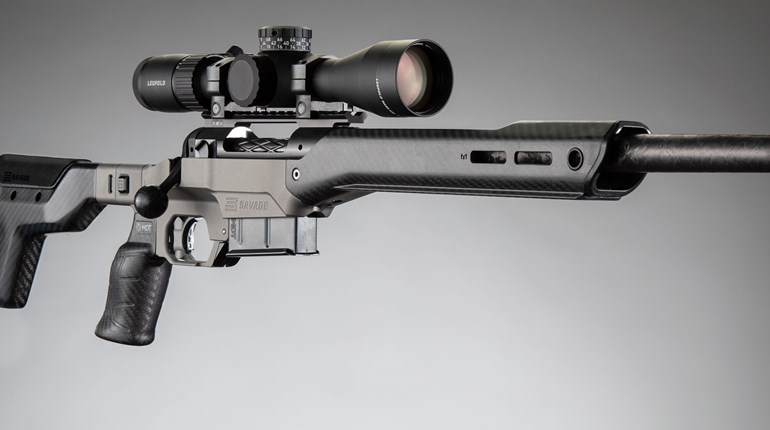
There is one important point often ignored in most of the current discussions about long-range shooting. What happens after the bullet arrives?
Hitting the target is fine—if that’s the only goal. For most shooters it is; as long as the spotter can see the hit, the goal is accomplished. However, in tactical applications there is a different motivation for hitting the target. When your goal is to neutralize something; either an enemy or a piece of working machinery, terminal ballistics become very important. If you have bad guys on the perimeter and you need to stop them or smash something in their truck so it can’t advance further, that goal has much different requirements than making a visible mark on the target or making a piece of steel swing on a chain.
I think it’s safe to assume that at extreme distances, no bullet will expand reliably, so the diameter of the bullet is the size of the hole. The diameter of that hole, and/or the damage the bullet will cause is determined in part by the retained energy the bullet has on impact.
Let’s say you are a hotshot who can hit a target at a mile with boring regularity. If you are shooting a 6.5 Creedmoor or .308 Win., the bullet arrives with less than 300 ft.-lbs. of energy. That’s a .38 Spl. +P handgun hit. If you have a .300 Win. Mag., the bullet impacts with 385 ft.-lbs. of energy, about the same as a 9 mm handgun. The .338 Lapua Mag. is a touch better; it hits with 745 ft.-lbs., a little less than a .44 Mag. handgun. None of these will do real damage to something like a truck engine.

Then there is the .50 BMG. With the Hornady 750-grain factory load, the half-inch diameter bullet impacts with 3,790 ft.-lbs. of retained energy—at 1 mile. That’s more than double the energy of all four of the other cartridges combined. It’s more energy than the 6.5 Creedmoor, .308 Win. or .300 Win. Mag. generate at the muzzle, and only a bit less than the .338 Lapua Mag.’s 4,504 ft.-lbs. of energy at the muzzle. At a mile, the .50 BMG has the same energy a .338 Win. Mag., a cartridge capable of hunting dangerous big-game, has at the muzzle. Beyond that, the .50 BMG throws a bigger, heavier bullet with almost twice the momentum.
If your goal is defense and you need a rifle to break things or discourage bad guys effectively, even at long range, nothing else comes close. As I wrote in my new book, “Nothing says, ‘Go away and leave me alone’ quite like the .50 BMG.”
If the target is closer, well, this Hornady load exits the muzzle with 13,241 ft.-lbs. of energy. That’s way more than double the energy of the most of the bad-ass elephant guns. Quite simply, nothing that you can legally own in a non-NFA firearm and shoot from your shoulder compares.

The .50 BMG is a scaled-up .30-’06 Sprg. cartridge. Size matters with bullets, and this is about as big as it gets in a shoulder-fired rifle. The .50 BMG has no peers when you want to smash stuff, punch big holes and end problems. The guns are heavy, the recoil stout and the muzzle blast fearsome, but when you absolutely must get the job done, the .50 BMG is in a class alone.
While firing an M2 machine gun can be a wonderful, life-altering experience, for civilian use of the .50 BMG, we are looking at primarily bolt-action or semi-auto rifles. There is a huge selection of guns on the market, ranging from uppers you can put on an AR-15 lower to full-blown, high-dollar precision rifles. The only limit is your budget. I have shot many of these options with wide-ranging results, but the best I have tried is the Accuracy International AX50. This rifle costs more than a new Harley Davidson Sportster, but it’s a thing of beauty for a hardcore shooter.
Accuracy International is a British firm that was formed in 1978 and currently has 83 employees, including nine based at a facility in Fredericksburg, VA. The company develops and manufactures sniper rifles for military and law enforcement as well as civilian shooters. On the competition side, AI rifles are revered by long-range shooters and Precision Rifle Series (PRS) competitors. British forces have used AI rifles since 1985 and, in 2008 the Ministry of Defence re-equipped all relevant U.K. forces with the company’s L115A3 sniper-rifle system.
An AI rifle holds the distinction of being used for the longest recorded successful sniper shot. British sniper Craig Harrison made a shot of 1.54 miles (2,707 yards), while serving in Afghanistan. He made three hits; two took out machine gun operators and the third disabled the machine gun. The gun he used was the .338 Lapua Mag. AI Model L115A3.
The .50 BMG AX50 is the big brother to that rifle, and probably would have been a better choice. My ballistic software only goes to 2,500 yards, but at that distance, the .338 Lapua Mag. has 399 ft.-lbs. of retained energy, while the .50 BMG has 2,232 ft.-lbs.
The AX50 is also battle-proven and may be the apex of magazine-fed, bolt-action .50 BMG rifles. The company’s website says “This Accuracy International .50-caliber is designed...as an anti-materiel weapon system.” That means it’s a good choice for breaking any stuff that needs to be broken.
The workmanship on this rifle is outstanding. Fit and finish is excellent and all the parts are fitted with precision. It runs smooth and easy and I didn’t experience a single function issue while shooting more than one hundred rounds.
It has a 27-inch barrel that measures 1.070-inch in diameter behind the muzzle brake. The gun is 4 feet, 7.5 inches long and weighs 24.6 pounds on my scale, empty and without optics. The three-chamber muzzle brake is 2.055 inches in diameter and is more than 5 inches long. It is both screwed on and tension-clamped, which should tell you something about what happens at the muzzle end of a .50 BMG barrel when you touch off a round.

The six-lug bolt is 1.070-inches in diameter, and is 11.5 inches long. The magazine is 6 inches long. This is a big rifle; nothing about it would ever be described as “petite.” It’s big, bad and powerful. This is a big-boy specialty toy. It is the bludgeon class of rifles. It is a mission-driven gun and has only one job. That is to deliver a very heavy, half-inch bullet where it needs to go very quickly and with lots of horsepower behind it.
Even with this effective muzzle brake and the heavy gun, this thing is—as are all .50 BMG rifles—a beast to fire. Recoil is about the same as a heavy, 3.5-inch turkey load in a shotgun or a dangerous-game rifle suitable for elephants in Africa, which is to say it’s certainly manageable, but not necessarily fun. The muzzle blast, though, is, well, thought provoking.
As much as anything else, it’s the blast that wears you out when shooting any .50 BMG, and this one is no exception. Of course, plugs and muffs are a must, but after a number of shots you just hit a wall. To be honest, that’s all part of the allure and mystique of a shoulder-fired .50 BMG rifle. Without all the drama, it just wouldn’t be a .50 BMG.
The AX50 is a chassis-built rifle with a flat-bottom, steel action bolted to a full-length aluminum chassis. The octagon-shaped fore-end tube is 14 inches long and has multiple attachment points on each of the six flats. The gun comes equipped with several rail sections, which can be positioned as needed. There are sling-attachment rings on both sides at the front of the fore-end tube.
The chassis has a short, polymer fore-end typical of an AI chassis. The single-stack, removable-box magazine holds five rounds. The grip and trigger guard are all one integral piece. The ambi safety was two positions and is well-marked in red. There are also two red half-inch dots on the receiver, one on either side and a 1⁄3-inch red dot in the bolt. These are covers for the three gas relief ports that will channel gases away from the shooter in the event of a case rupture. They not only keep dirt and debris out of the ports, they add a striking contrast to the look of the rifle.
The folding stock is adjustable for length-of-pull and for height of the cheek-piece. There is a telescoping bottom stud for supporting the toe of the rifle. It can be moved with a quick release and then turned on a thread to fine-tune it. One of my few complaints is that it would not stay in place and would slip, often with just the weight of the rifle.
The firing pin cannot protrude from the front of the bolt face unless the bolt is in the fully closed position, meaning the gun can’t fire out of battery. There is a cocking indicator at the bottom of the bolt that shows if the rifle is ready to fire.

The two-stage trigger is the best trigger I have ever used on a .50 BMG firearm. It breaks at 4 pounds, 6 ounces. The first stage is 3 pounds, 3 ounces, so the effective trigger pull is only 1 pound, 3 ounces. This trigger is a huge asset for precision long-range shooting.
The barrel can be changed in less than 10 minutes using the barrel-change kit, but if you shoot it out, you are a better man than me. I don’t know how many rounds it takes to shoot out a high-quality barrel in a .50 BMG, but I know how many I can manage in a range session. I suspect I would have to live to be older than Methuselah to ever wear out this barrel. But, if I did, it’s nice to know changing it is no more work than changing a tire on my truck.
This rifle is amazingly accurate with ammo it likes. This is not a competition rifle; it’s a battle rifle and the chamber is cut very generously so that it can fire any ammo available, even ammo in less-than-perfect condition. With that in mind, the accuracy is excellent. I can say that of the .50 BMG rifles I have formally tested, this is the most accurate by a rather wide margin.
In conclusion, if you want to smack stuff very hard and at any range, the Accuracy International AX50 is the best delivery system I have ever encountered for the great
.50 BMG cartridge.





































